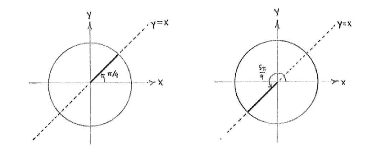Solution 4.4:1d
From Förberedande kurs i matematik 1
(Difference between revisions)
m (Lösning 4.4:1d moved to Solution 4.4:1d: Robot: moved page) |
|||
| Line 1: | Line 1: | ||
| - | {{ | + | Because |
| - | < | + | <math>\tan v=\frac{\sin v}{\cos v}</math>, the condition |
| - | {{ | + | <math>\text{tan }v=\text{1 }</math> |
| + | gives | ||
| + | <math>\text{sin }v=\text{ cos }v</math>, i.e. we look for angles in the unit circle whose | ||
| + | <math>x</math> | ||
| + | - and | ||
| + | <math>y</math> | ||
| + | -coordinates are equal. | ||
| + | |||
| + | After drawing the unit circle and the line y=x, we see that there are two angles which satisfy these conditions, | ||
| + | <math>v={\pi }/{4}\;</math> | ||
| + | and | ||
| + | <math>v=\pi +{\pi }/{4}\;={5\pi }/{4}\;</math> | ||
| + | |||
| + | |||
[[Image:4_4_1_d.gif|center]] | [[Image:4_4_1_d.gif|center]] | ||
Revision as of 12:38, 30 September 2008
Because \displaystyle \tan v=\frac{\sin v}{\cos v}, the condition \displaystyle \text{tan }v=\text{1 } gives \displaystyle \text{sin }v=\text{ cos }v, i.e. we look for angles in the unit circle whose \displaystyle x - and \displaystyle y -coordinates are equal.
After drawing the unit circle and the line y=x, we see that there are two angles which satisfy these conditions, \displaystyle v={\pi }/{4}\; and \displaystyle v=\pi +{\pi }/{4}\;={5\pi }/{4}\;

